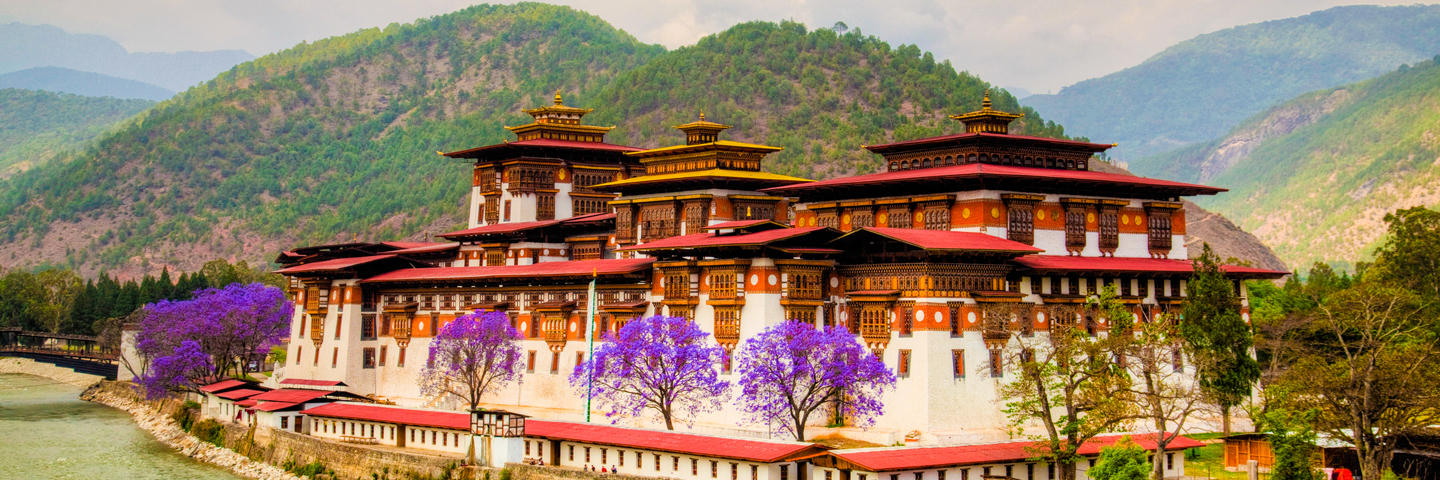CLIMATE OF BHUTAN
The Kingdom of Bhutan or simply Bhutan is one of the forty-nine landlocked countries in the world. Located in the lap of the might Eastern Himalayas, this quaint little country shares its boundaries with the Indian states of Sikkim, Assam, West Bengal, and Arunachal Pradesh. Situated at an elevation of 200-7,000m, this Last Himalayan Kingdom enjoys a mix of climate.
Being close to India, the south of Bhutan gets much influenced by the Indian monsoons at certain places at distinct times of the year. This part of the country usually receives heavy rain accompanied by high temperature level and humidity. On the other hand, the northern part experiences quite harsh climatic conditions along with heavy snowfalls throughout the winter.
Eastern Bhutan mostly remains warmer than Western Bhutan throughout the year. Lastly, the Central Bhutan relishes a sub-tropical climate with chilling winter.
With such a variation in climate, Bhutan’s weather conditions can be broadly classified into four different types: Spring, Summer, Autumn, and Winter.
Spring – March, April, and May
The advent of spring in Bhutan happens in the month of March and continues till the end of May. During the course of these three months, the southern parts of the country experiences a subtropical climatic condition with the heat level and humidity continuing to increase. However, in contrast to the rise in temperature, nights usually get cooler; especially across places like Thimphu, Bumthang, and Paro Valley.
As spring makes its way to Bhutan, the country turns into an enchanting display of colours as the rhododendrons and other wild flowers starts blooming with all their grace. The valleys also start turning greener and makes it for a tempting season to go outdoors and adore the untouched beauty of Bhutan.
For the thrill seekers, spring also serves as a befitting time to embark on high altitude treks. Trek to Jhomolari, Dagala, and Druk Path are some of the must to do treks during spring in Bhutan. In addition to trekking and hiking, visitors can also opt for local sightseeing as the atmosphere gains much visibility during these three months.
Summer – June, July, and August
July marks the onset of summer in Bhutan. Though temperature starts rising by early June, it reaches its peak only by the mid of July and continues till the mid of August. By the end of July, the country experiences spell of heavy monsoon that might reach up to the beginning of September. Though the arrival of monsoon showers brings in a relief from the rising temperature, visiting places like Paro Valley, Thimphu, Punakha, and other close by reasons might be a challenge as they receive very fair amount of rainfall.
Amongst all the corners of Bhutan, the Southern belt receives the maximum showers, and thus, becomes a bit hostile for tourists to manoeuvre around. Compared to the southern belt, Central and Western Bhutan also receives a fair amount of rainfall and can be good choices for visitors looking for budget-friendly Bhutan tours. Well, though the heat and monsoon showers put tourism into almost a stagnant position, summer could be an ideal choice for tourists who are either wish to enjoy nature’s utmost beauty amidst rain or are looking for pocket-friendly deals on Bhutan tours.
Autumn – September, October, and November
The tail end of September marks the arrival of autumn in Bhutan. By this time, the heat level comes down and gets stable enough to make the ambience calm and promising for all sorts of tourism activities in the country. Also, as monsoon reaches its end by the starting of September, visitors can easily move from across destinations without any hassles.
With the beginning of this season, the sky gets clearer, which in turn rewards the visitors with breath-taking views of the Himalayan Range and other peaks around the country. While leisure travellers revel in the beauty of the Land of Thunder Dragon by indulging in different types of sightseeing tours, adventure enthusiasts embark on Jhomolari, Druk Path, Dagala, and other enthralling treks to discover the untouched nature of Bhutan. At higher altitudes, thrill seekers even opt for the Snowman Trek that takes the trekker to a maximum height of 5,350m, to adore and relish the raw beauty of Mother Nature.
Winter – December, January, and February
Winter in Bhutan initiates with the starting of December and continues almost till the end of February. During these three months, the days usually gets warmer as compared to the crispiness of nights. During this season, Northern Bhutan along with some of the other region receives the highest snowfall. As a result, life through the high passes like Dochula, Pele La, and Chele La becomes stagnant; the passes in fact remains closed for few months due to the heavy snowfall.
However, if in the valleys, visitors can revel in the alluring charm of the distant snow-capped peaks. The clear blue winter skies with a light and dusty blow of the snowflakes make life among the valley much exciting and adorable. During this season Punakha Valley usually becomes a hotspot for most of the travellers to Bhutan. As this valley lies in the lower altitude, visitors could often be seen participating in the Samtegang and Nabji Korphu treks which are rated as moderate treks in Bhutan.
If you are planning for a Bhutan trip, or are looking for the best time to visit the country, you must consider spring, autumn, and winter seasons. During these three seasons, the mercury level usually stays low and the atmosphere gains maximum visibility. However, you should consider avoiding the higher altitude places during the winter as they mostly receive heavy snowfall during the season.
On the other hand, if you are looking for budget-friendly Bhutan tours, you can plan your trip during the summer as it is considered as an off-season for Bhutan tourism. Hotels, transportations, and other tourist facilities can be booked at affordable prices as the influx of tourist reduces significantly during the summer months.
Get Instant Call Back
Why Choose us ?
What makes us diffrent from other tour package companies










